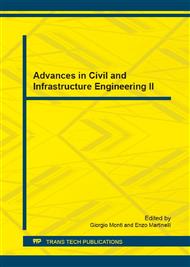p.146
p.156
p.166
p.173
p.183
p.191
p.204
p.210
p.222
Pounding Response Spectra of Bridge Decks
Abstract:
Pounding-induced damage to structures, either buildings or bridges, is systematically observed after significant earthquakes. This has emphasized the necessity of accounting for this phenomenon either in the design of new bridges or the seismic assessment of existing bridges. For this reason, practitioners concerned with bridge structures should be provided with concise computational tools to correctly quantify the effects due to pounding. One such tool is represented by pounding spectra, which were already introduced a couple of decades ago. This work presents a proposal of simplified equations for pounding-related displacement spectra. The first part of this paper presents the computational aspects arising when modeling such complex phenomenon. The second part presents the results of numerical analyses, in terms of displacement spectra. The third part presents a set of simple expressions to allow practitioners easily evaluate pounding-related effects in terms of displacement amplification with respect to the no-pounding condition.
Info:
Periodical:
Pages:
183-190
Citation:
Online since:
July 2016
Authors:
Keywords:
Price:
Сopyright:
© 2016 Trans Tech Publications Ltd. All Rights Reserved
Share:
Citation:


